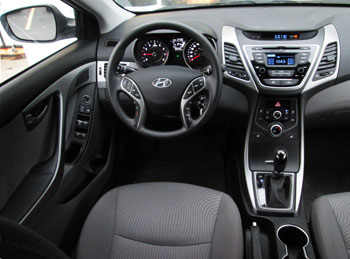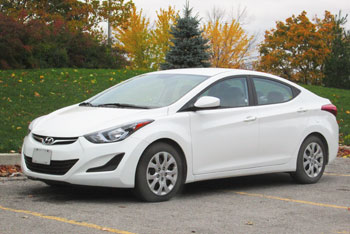Hyundai Elantra sedan 2011-2016: pros and cons, common problems
By Vlad Samarin, Updated: August 30, 2023
The 5-th gen. Hyundai Elantra sedan is a sleek fuel-efficient compact car. It comes with a 1.8L or 2.0L 4-cylinder engine and an automatic or manual transmission.The 2013-2016 Hyundai Elantra sedan received a five-star NHTSA rating. The Elantra offers a nicely done interior and a comfortable driving experience.
Pros:
- Sleek styling, nicely-done interior.
- Quick acceleration, comfortable driving experience.
- Fuel Economy: the 2013-2015 Elantra sedan auto gets 27/37 mpg city/highway.
- 5-star overall NHTSA crash test rating, (203-2016 Elantra).
- Risk of potential engine failure.
- No spare tire in some trims
- Some road and engine noises are noticeable
- Interior materials could be better.
A problem with a transmission range switch (inhibitor switch) may cause the vehicle to start in Neutral but not to start in Park. One symptom of this issue is when the transmission shifter position indicator "P" is not displayed on the instrument panel. The repair is not very expensive; the transmission range switch must be replaced. The NHTSA website has a number of complaints about this issue. We found a few YouTube videos explaining the problem and the repair.
There are a larger number of complaints about the engine on the NHTSA website for the 2013 Elantra, compared to other model years. CarComplaints.com rates the 2013 Elantra poorly, with most complaints also related to the engine.
The Hyundai TSB 13-AT-014 for the 2011- Elantra (MD/UD) mentions a problem related to the transmission input and output speed sensors causing the codes P0717, P0721 and P0722. The repair procedure involves the inspection of the harness and the connector, as well as installing a new input/output speed sensor inside the transmission.
The Check Engine light with the code P0335 can be caused by a bad crankshaft position sensor, which is not an expensive part.
Failed ignition coils can cause the engine to misfire as well as the Check Engine light with the codes P0301-P0304.
Several owners mentioned audio system failures.
Exhaust rattles are not uncommon, but they are not very expensive to repair.
Hyundai has issued several recalls; check for details at the NHTSA website.
Summary: We recommend avoiding the 2011-2013 Elantra model years due to engine and other problems. If you are buying a used Hyundai Elantra, consider getting a good powertrain warranty. Replacing an engine will be expensive if not covered by the warranty.
Among similar cars, Honda Civic, Toyota Corolla and Mazda 3 are more reliable. We also spoke to two Elantra owners; both had the Elantra for over 4 years. Both owners were generally happy with the car. One owner only mentioned the peeling steering wheel and some issues with the transmission sensors. If you have an engine problem with your Elantra, check with a Hyundai dealer first for possible warranty coverage.
Engine: The Elantra GLS, SE and Limited sedan comes with a 148-hp 1.8L DOHC 4-cylinder engine with the code name "Nu." The 2014+ Elantra sedan SPORT comes with a 173-hp direct-injected (GDI) 2.0L version of this engine. Direct injection means that fuel is injected directly into the engine combustion chamber under much higher pressure. Read also: Pros and cons of buying a car with Direct Injection. The Nu engine doesn't have a timing belt; it uses a maintenance-free timing chain that doesn't need to be replaced in regular intervals.
Handling and ride: The Elantra handles well and is maneuverable in city driving; the turning diameter is 34.8 ft. The downside is that some road noise is noticeable, especially when driving on a rough road. The engine noise is pronounced too.
Mechanical: The Elantra sedan rides on MacPherson struts in the front and a torsion bar axle in the rear suspension. Rear brakes are discs. The steering is electrically assisted.
Related reviews:
Toyota Corolla 2014-2018
Honda Civic 2012-2015
Used Chevrolet Cruze 2011-2015
Used Toyota Corolla 2009-2013
Mazda 3 2014-2018
Used Nissan Versa 2007-2011
Dodge Dart 2013-2016
Used Honda Civic 2006-2011
Mazda 3 2010-2013
Model line-up: In the U.S., the 2011 Elantra sedan was available in two trim levels: the base GLS and Limited. The GLS comes with standard power windows and locks, tilt steering, an iPod USB jack, and 15- or 16-inch tires and optional Bluetooth. The Elantra Limited offers a sunroof, fog lights, heated leather front and rear seats and optional 17-inch tires. Optional premium audio system, navigation, rearview backup camera and automatic headlights were available on both trim levels. For 2014, the base trim level was renamed SE. The Elantra sedan SPORT with the 2.0L 173-hp engine was added to the lineup.
Maintenance: The Elantra is not very expensive to maintain.
Advertisement
In our view, the engine oil should be changed at least every 5,000 miles, as some amount of oil is normally consumed between oil changes. The automatic transmission fluid is recommended to be changed every 60,000 miles (for severe conditions). Spark plugs must be replaced at or before 105K miles. Tires must be rotated every 7,500 miles.

